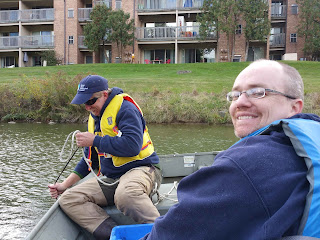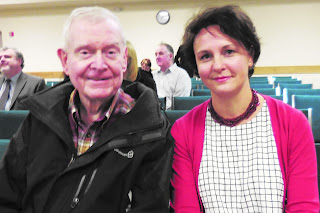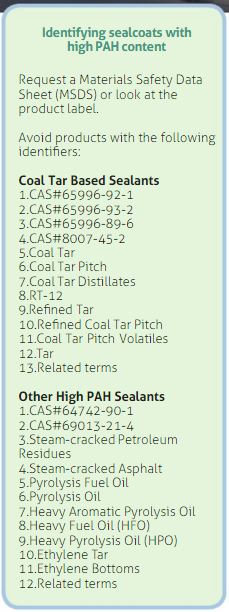Toxic detention ponds
First, the bad news. In late October, HRWC staff took sediment samples from three detention ponds around the City of Ann Arbor. The results were startling. Of the ten PAH compounds with scientifically identified “probable effects concentrations” (PEC, i.e. the concentration that results in health impacts or death in aquatic organisms), sediments from the Malletts Creek pond exceeded the PEC for eight PAH compounds! Some of those PAHs are known carcinogens. Sediments in the Traver and Fleming ponds exceeded the PEC for 6 and 4 of the PAH compounds, respectively. In the Malletts Creek sample, the PEC for one PAH was exceeded by more than 10-fold. The bottom line is these detention pond sediments are highly toxic! Other studies have indicated that between 50–84 percent of PAHs in detention pond sediments originate from coal tar sealants. It appears that Ann Arbor (and most probably other paved areas in the watershed) has a problem with coal tar leaching.
 |
| Ric Lawson and Paul Steen sample sediment in detention ponds. |
The results from the HRWC samplings are consistent with findings from USGS and other research scientists nationally. Further, it is likely that sediments from stormwater runoff elsewhere (e.g. in catch basins and at storm pipe outfalls) are also toxic.All of these sediments require proper disposal.
Local Legislative Progress
Now, the good news. Initial outreach to HRWC board members, local elected officials and watershed residents led to a number of communities highly interested in taking action to restrict the use of coal tar sealcoat. Here’s a glimpse of the gains made:
- Washtenaw County prohibits the use of coal tar sealcoat for any pavement work they contract.
- Scio Township Planning Commission invited a presentation on the issue and a ban is being considered by the Ordinance Committee.
- Ann Arbor Environmental Commission presented a resolution to ban coal tar sealcoat and other high PAH sealcoat products to City Council for consideration in the next few months.
- The Department of Environmental Quality is developing statewide guidance on the proper (and regulated) disposal of high-PAH detention pond sediments.
Ground-breaking legislation
Finally, the really good news. Two game-changing successes warrant celebration. In December of 2015, VanBuren Township’s Board of Trustees unanimously passed a ban on coal tar and other high PAH sealcoats –the first of its kind in the nation! In addition, Representative Kristy Pagan (D-Canton) introduced a bill to the State Legislature that would do the same. Much of the credit for the
first municipal-wide ban in Michigan belongs to Dr. David Wilson. A tireless HRWC volunteer and board member, Dave is a retired chemist and Van Buren Township Environmental Commission member.
 |
| Dr. David Wilson & Rebecca Esselman |
He picked up this issue with fervor. Dave read the 2014 HRWC newsletter article and then shepherded the issue through the government process. At the same time, Dave directed outreach to residents of the township by speaking to audiences at the library, Rotary and the Grange. He wrote several articles for the Belleville Independent to raise awareness and support. And heinitiated countless conversations with decision-makers critical to passing the ban, lending his expertise, answering questions and advocating for action.
 On December 17th, at a township board meeting, the ordinance passed with unanimous support. The Board thanked Dr. Wilson and HRWC for bringing the issue to their attention and helping get an unnecessary pollutant out of the township.That same week, as the congressional session closed for the year, HRWC worked quickly with Representative Pagan’s office to finalize coal tar legislation to introduce to Michigan legislators. House Bill 5174 has several other sponsors from the area who had been briefed on the issue by HRWC staff over the past year including representatives Jeff Irwin (D-Ann Arbor), Gretchen Driskell (D-Saline),Bill LaVoy (D-Monroe) and Adam Zemke (D-Ann Arbor). While state legislation has a long road ahead, there is plenty of work to be done in the coming year to build support for a state level ban and there are several local Representatives poised to do just that.
On December 17th, at a township board meeting, the ordinance passed with unanimous support. The Board thanked Dr. Wilson and HRWC for bringing the issue to their attention and helping get an unnecessary pollutant out of the township.That same week, as the congressional session closed for the year, HRWC worked quickly with Representative Pagan’s office to finalize coal tar legislation to introduce to Michigan legislators. House Bill 5174 has several other sponsors from the area who had been briefed on the issue by HRWC staff over the past year including representatives Jeff Irwin (D-Ann Arbor), Gretchen Driskell (D-Saline),Bill LaVoy (D-Monroe) and Adam Zemke (D-Ann Arbor). While state legislation has a long road ahead, there is plenty of work to be done in the coming year to build support for a state level ban and there are several local Representatives poised to do just that.
PAH vs. Coal Tar
Unique to HRWC’s campaign is the regulation of not only coal tar sealcoat, but any sealcoat product high in PAH content. Van Buren’s legislation is the first in the nation to regulate all high PAH content (over one percent, by weight) sealcoats. The introduced statewide legislation would do the same. This amendment became necessary as new sealcoat products have been introduced to the market and are being branded as “non-coal tar”or “environmentally friendly” but in reality still contain harmful quantities of PAHs, the substances of concern in coal tar sealcoat.(See the box at right for tips on identifying sealcoats with high PAH content.)
HRWC will continue its efforts in 2016 by working with a growing number of communities interested in banning coal tar sealcoat,reaching out to residents of the watershed with information to help people find less harmful ways to maintain paved surfaces and advocating at the state level for better regulations and laws that protect people and freshwater ecosystems from the harmful effects of PAH exposure.



